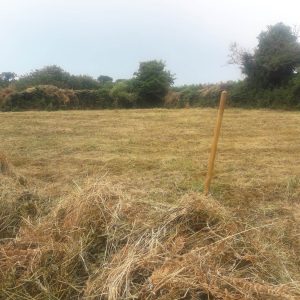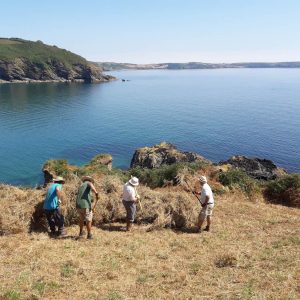 I am new to the Roseland and joined the Ranger team here in March. What a wonderful place to work, to walk, to be. Headlands. Ocean. Farmland. Views!
I am new to the Roseland and joined the Ranger team here in March. What a wonderful place to work, to walk, to be. Headlands. Ocean. Farmland. Views!
The potential for habitat restoration here is bright andexciting. The National Trust is focussing in on nature, on soils, on restoring habitats and making our land thebest it can be for our wildlife, creating wildlife corridors and biodiversity rich havens.
We’ve been talking about hay-meadows all year. In the last 40 years we have lost 97% of our wild flower hay meadows in the UK. This is mostly due to the mechanisation of farming and tractors replacing heavy horses. You don’t need to feed tractors hay. We want to restore as many areas of hay meadow as we can. And introduce this habitat to new areas. We’ve been labouring for hay-meadows all summer, cutting grasses, drying and turning hay, flicking and rowing up, raking, baling and removing. It is a slow restoration process from grassy arable field to wildflower hay meadow.
After years of fertilizer soils are nutrient rich, which means that grasses that grow here are aggressive, they’re fast, out-competing slow growing delicate wild flowers. So we let the grasses grow, and then we cut and remove them, gradually stripping the soil oft hese historically added nutrients. And so the grasses are reduced in their voracity, and wild flowers are given a chance. We can improve this chance by sowing seeds on bare ground. As the meadow establishes we continue the cycle of grow, cut, rake, row, bale, remove, keeping nutrient levels low, resulting in optimum conditions for wild flowers.
wild flowers. So we let the grasses grow, and then we cut and remove them, gradually stripping the soil oft hese historically added nutrients. And so the grasses are reduced in their voracity, and wild flowers are given a chance. We can improve this chance by sowing seeds on bare ground. As the meadow establishes we continue the cycle of grow, cut, rake, row, bale, remove, keeping nutrient levels low, resulting in optimum conditions for wild flowers.
We hope that one day, not too far away, we will walk in fields of wildflowers; pinks of field madder, weasel snout and common sorrel, yellows of birds-foot trefoil, lady’s bedstraw and yellow rattle, purples of field scabious, knapweed and red clover, whites of ox-eye daisies, wildcarrot and yarrow, and blues, perhaps speedwells and forget-me-nots.
 So watch for the cycles of this process, at Towan, St Anthony Head, and that strip just back from the Carne-Pendower footpath (we are calling it Gwendra meadow). Ask us about getting involved and volunteering some time to the countryside and wildlife ofthe Roseland. Speak to the local Wild Roseland Group about their planting plans. The establishment of wild flowers on any scale will benefit our invertebrates, our butterflies, our bees and our birds. Let’s get excited about these tiny plants, whilst we await their emergence in the spring. Perhaps not next spring but not too far off…
So watch for the cycles of this process, at Towan, St Anthony Head, and that strip just back from the Carne-Pendower footpath (we are calling it Gwendra meadow). Ask us about getting involved and volunteering some time to the countryside and wildlife ofthe Roseland. Speak to the local Wild Roseland Group about their planting plans. The establishment of wild flowers on any scale will benefit our invertebrates, our butterflies, our bees and our birds. Let’s get excited about these tiny plants, whilst we await their emergence in the spring. Perhaps not next spring but not too far off…
